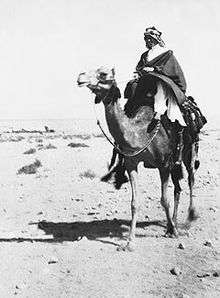Lowell Thomas
| Lowell Thomas | |
|---|---|
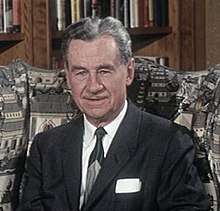 Lowell Thomas, c. 1966 | |
| Born |
Lowell Jackson Thomas April 6, 1892 Woodington, Ohio, U.S. |
| Died |
August 29, 1981 (aged 89) Pawling, New York, U.S. |
| Education | Victor High School (1910) |
| Alma mater |
Valparaiso University Denver University Princeton University |
| Occupation | Writer, broadcaster |
| Employer | Chicago-Kent College of Law |
| Spouse(s) |
Frances Ryan (m. 1917; her death 1975) Marianna Munn (m. 1977; his death 1981) |
| Children | Lowell Thomas Jr. |
| Parent(s) |
Harry George Thomas Harriet Wagoner |
Lowell Jackson Thomas (April 6, 1892 – August 29, 1981) was an American writer, actor, broadcaster, and traveler, best remembered for publicising T. E. Lawrence (Lawrence of Arabia). He was also involved in promoting the Cinerama widescreen system.[1]
Early life
Thomas was born in Woodington, Darke County, Ohio, to Harry and Harriet (née Wagoner) Thomas. His father was a doctor, his mother a teacher. In 1900, the family moved to the mining town of Victor, Colorado. Thomas worked there as a gold miner, a cook, and a reporter on the newspaper.
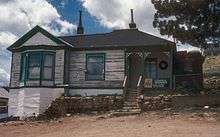
In 1911, Thomas graduated from Victor High School where one of his teachers was Mabel Barbee Lee.[2] The following year, he graduated from Valparaiso University with bachelor's degrees in education and science. The next year, he received both a B.A. and an M.A. from the University of Denver and began work for the Chicago Journal, writing for it until 1914. Thomas also was on the faculty of Chicago-Kent College of Law (now part of Illinois Institute of Technology), where he taught oratory from 1912 to 1914. He then went to New Jersey where he studied for a master's at Princeton University (he received the degree in 1916) and again taught oratory at the university.
Career
Thomas was a relentless self-promoter, and he persuaded railroads to give him free passage in exchange for articles extolling rail travel. When he visited Alaska, he hit upon the novel idea of the travelogue, movies about faraway places. When the United States entered World War I, he was part of an official party sent by President Wilson, former president of Princeton, to "compile a history of the conflict." In reality, the mission was not academic. The war was not popular in the United States, and Thomas was sent to find material that would encourage the American people to support it. Thomas did not want to merely write about the war, he wanted to film it. He estimated that $75,000 would be needed for filming, which the U.S. government thought too expensive, and so he turned to a group of 18 Chicago meat packers. (He had done them a favor by exposing someone who was blackmailing them, without the damaging material becoming public.)
Lawrence of Arabia
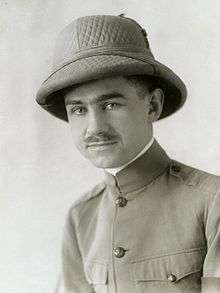
Thomas and cameraman Harry Chase first went to the Western Front, but the trenches had little to inspire the American public. They then went to Italy, where he heard of General Allenby's campaign against the Ottoman Empire in Palestine. Thomas traveled to Palestine as an accredited war correspondent with the permission of the British Foreign Office, where he met T. E. Lawrence, a captain in the British Army in Jerusalem. Lawrence was spending £200,000 a month encouraging the inhabitants of Palestine to rebel against the Turks. Thomas and Chase spent several weeks with Lawrence in the desert, though Lawrence said "several days." Lawrence agreed to provide Thomas with material on the condition that Thomas also photograph and interview Arab leaders such as Emir Feisal.
[Lowel Thomas] went to Jerusalem where he met Lawrence, whose enigmatic figure in Arab uniform fired his imagination. With Allenby's permission he linked up with Lawrence for a brief couple of weeks ... Returning to America, Thomas, early in 1919, started his lectures, supported by moving pictures of veiled women, Arabs in their picturesque robes, camels and dashing Bedouin cavalry, which took the nation by storm, after running at Madison Square Gardens in New York. On being asked to come to England, he made the condition he would do so if asked by the King and given Drury Lane or Covent Garden ... He opened at Covent Garden on 14 August 1919 ... And so followed a series of some hundreds of lecture–film shows, attended by the highest in the land ..."[3]
Thomas shot dramatic footage of Lawrence and, after the war, toured the world, narrating his film With Allenby in Palestine and Lawrence in Arabia and making Lawrence—and himself—household names. The performances were highly dramatic. At the opening of Thomas's six-month London run, there were incense braziers, exotically dressed women dancing before images of the Pyramids, and the band of the Welsh Guards playing to provide the accompaniment. Lawrence saw the show several times; he later claimed to dislike it, but it generated valuable publicity for his own book. To strengthen the emphasis on Lawrence in the show, Thomas needed more photographs of him than Chase had taken in 1918. Lawrence claimed to be shy of publicity, but he agreed to a series of posed portraits in Arab dress in London. Thomas later said of Lawrence, "He had a genius for backing into the limelight."
Thomas and Lawrence's initially friendly relations became more prickly as Thomas's film grew in popularity and as Thomas ignored several alleged requests from Lawrence to end it. In fact, the film gave Lawrence a degree of publicity that he had never previously experienced. Newspapers were keen to print his attacks on government policy, and politicians began to pay attention to his views. At the end of 1920, he was invited to join the British Colonial Office under Winston Churchill as an adviser on Arab affairs. Lawrence said that he never forgave Thomas for exploiting his image, and called him a "vulgar man."
For his part, Thomas genuinely admired Lawrence and continued to defend him against attacks on his reputation.[4] Lawrence's brother Arnold extended Thomas an olive branch and allowed him to contribute to T.E. Lawrence by his Friends (1937), a collection of essays and reminiscences published after Lawrence's death.[5]
About four million people saw the Thomas film around the world, and it made Thomas $1.5 million. He later wrote the book With Lawrence in Arabia (1924) about his time in the desert and Lawrence's exploits during the war. It was the first of fifty-six volumes.
.jpg)
Cinerama
During the 1920s, Thomas was a magazine editor, but he never lost his fascination with the movies. He narrated Twentieth Century Fox's Movietone newsreels until 1952. That year, he went into business with Mike Todd and Merian C. Cooper to exploit Cinerama, a movie format that used three projectors and an enormous curved screen with 7-channel surround sound. (He produced the first movie/documentary in Cinerama: This is Cinerama, the third: Seven Wonders of the World, and the fourth: Search for Paradise) in this format in 1956, with a 1957 release date.[6] Cinerama features were well-received, but the company discontinued the three-projector system by 1963, with the enormous costs and technical difficulties in film production and presentation, in favor of a single-camera 70mm system which lacked the visual impact of true Cinerama. A quarter-century later, Thomas was still raving about Cinerama in his memoirs and wondering why someone wasn't trying to revive it.
Newscaster
In 1930, he became a broadcaster with the CBS Radio network, delivering a nightly news and commentary program. After two years, he switched to the NBC Radio network but returned to CBS in 1947. In contrast to today's practices, Thomas was not an employee of either NBC News or CBS News. Prior to 1947, he was employed by the broadcast's sponsor Sunoco. He returned to CBS to take advantage of lower capital-gains tax rates, establishing an independent company to produce the broadcast which he sold to CBS. He hosted the first-ever television news broadcast in 1939 and the first regularly scheduled television news broadcast (even though it was just a camera simulcast of his radio broadcast) beginning on February 21, 1940 over local station W2XBS (now WNBC) New York.[7] It is not known whether all or some of the radio/TV simulcasts were carried by the two other television stations capable of being fed programs by W2XBS at the time, which were W2XB (now WRGB) Schenectady and W3XE (now KYW-TV) Philadelphia).[8][9]
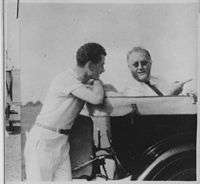
In the summer of 1940, Thomas anchored the first live telecast of a political convention, the 1940 Republican National Convention which was fed from Philadelphia to W2XBS and on to W2XB. Reportedly, Thomas wasn't even in Philadelphia, instead anchoring the broadcast from a New York studio and merely identifying speakers who addressed the convention.

The television news simulcast was a short-lived venture for him, and he favored radio. Indeed, it was over radio that he presented and commented upon the news for four decades until his retirement in 1976, the longest radio career of anyone in his day (a record later surpassed by Paul Harvey). "No other journalist or world figure, with the possible exception of Winston Churchill, has remained in the public spotlight for so long," wrote Norman R. Bowen in Lowell Thomas: The Stranger Everyone Knows (1968). His signature sign-on was "Good evening, everybody" and his sign-off "So long, until tomorrow," phrases that he would use in titling his two volumes of memoirs.
Television
Thomas is also known for two television programs: High Adventure, a series of travelogue specials filmed in the late 1950s for CBS; and Lowell Thomas Remembers, a 1970s PBS series that reviewed major news events from 1919 through 1975 on a year-by-year basis using newsreel footage, including some that Thomas originally narrated for Movietone.
"The world's foremost globetrotter" took his radio show on his travels, broadcasting from the four corners of the globe. Once on the Spanish Steps in Rome he was asked by a fellow American, "Lowell Thomas, don't you ever go home?" He was a fanatical skier, helping develop the Mont Tremblant Resort in Quebec and skiing near Tucson, Arizona.
Gaffes
Thomas's most amusing on-air gaffe occurred during one of his daily broadcasts in the early 1960s. He was reading a story "cold" (going on the air without pre-reading his copy, contrary to his usual practice) which contained the phrase "She suffered a near fatal heart attack". The line came out of Thomas's mouth as "She suffered a near fart … err fatal heart attack". Realizing instantly what he had said, he tried to continue but eventually collapsed into gales of laughter, which continued into – and beyond – his announcer's chuckling sign-off for the day.
Thomas' long-time friend and ghostwriter Prosper Buranelli wrote the nightly newscasts. The day's script was sent by teletype to Thomas' home in Pawling, NY from which he usually did his broadcast. One evening, Buranelli's final story was about an actress going into a Los Angeles hotel with a Great Dane. The dog's tail got caught in the revolving door and she sued the hotel for $10,000. Buranelli added a comment to the story to give Thomas a laugh before going on air, but Thomas read the story as written with Buranelli's comment, "Who ever thought a piece of tail was worth 10 grand?"
Another on-air mishap had Thomas reading a story about President Eisenhower's visit to Hershey, Pennsylvania "where he was greeted by the folks who make chocolate bars, with and without nuts." ("Nuts" is a euphemism for "testicles.") As Thomas read the next story, he could hear the announcer breaking up with laughter in the New York City studio, which caused Thomas to break up, as well. Air checks of some of Thomas' gaffes (as well as recreations of his "bloopers") are available to collectors.
Other activities
Thomas was a successful businessman. In 1954, he and his long-time business manager and partner Frank Smith bought a struggling UHF TV and radio station based in Albany New York and turned it into Capital Cities Communications, which took over the American Broadcasting Company in 1986. They also developed the Quaker Hill community in Dutchess County, New York, near Pawling where Thomas resided when not on the road. Thomas E. Dewey was among his neighbors, one of a huge circle of friends that included everyone from the Dalai Lama to Franklin D. Roosevelt.
In May 1955, the board of directors of the Lancaster and Chester Railway of South Carolina appointed him Press Agent in N.Y.C.[10]
Personal life
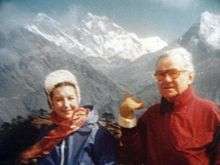
His wife of 58 years Frances "Fran" Ryan (1893–1975) often traveled with him. They were wed on August 4, 1917 and less than a month later they were off to Europe. Before her death in 1975,[11] they were the parents[12] of Lowell Thomas, Jr. (1923–2016), who was a film and television producer who collaborated with his father on several projects before becoming a State Senator, and later the Lieutenant Governor of Alaska in the 1970s. Thomas Jr. was an active bush pilot and environmental activist in Alaska; he died at his home in Anchorage on October 1, 2016 at the age of 92.
In 1977, Thomas was married a second time to Marianna Munn (1927–2010). They embarked on a 50,000-mile (80,000 km) honeymoon trip that took him to many of his favorite old destinations. Marianna died in Dayton, Ohio on January 28, 2010 after suffering renal failure.[13] Thomas died at his home in Pawling, New York in 1981.[1] He is buried in Christ Church Cemetery.[14][15]
Legacy and honors
The communications building at Marist College in Poughkeepsie, New York is named in honor of Lowell Thomas, after he received an honorary degree from the college in 1981. The Lowell Thomas Archives are housed as part of the college library.[16]
In 1945, Thomas received the Alfred I. duPont Award.[17] The award honors excellence in broadcast and digital journalism in the public service. The awards, established in 1942 and administered since 1968 by the Columbia University Graduate School of Journalism in New York City, are considered a broadcast equivalent of the Pulitzer Prize, another program administered by Columbia University.[18]
In 1976, President Gerald Ford awarded Thomas the Presidential Medal of Freedom.[19] He has two stars on the Hollywood Walk of Fame and was inducted into the National Radio Hall of Fame in 1989.[20]
Lowell Thomas Awards
Since 1980, the Explorers Club, where Thomas was a member, has annually presented the Lowell Thomas Award to "honor men and women who have distinguished themselves in the field of exploration". The awards are presented at a yearly dinner to a select group of people having made particular contributions in the specific area chosen to be that year's focus. Past recipients include Edmund Hillary, Isaac Asimov, David Doubilet,Emory Kristof, Ralph B White,Anatoly Sagalevitch[21] Mary Cleave, Buzz Aldrin, Bertrand Piccard, and Rosaly Lopes.[22]
Since 1985, the Society of (North) American Travel Writers (SATW) has held an annual Lowell Thomas Travel Journalism Competition for outstanding print, online, and multimedia works, for travel photography, and for audio and video broadcast. Past recipients included Elisabeth Eaves, Jeff Biggers, Peter Mandel, and National Geographic Traveler('08[23] and '09[24]).[25] The 2008-9 awards were judged by faculty members of the University of North Carolina at Chapel Hill School of Journalism and Mass Communication, coordinated by Monica Hill. There were 1,191 entries and awards in 25 categories.[24] In the 2007-8 awards, faculty members of the Missouri School of Journalism judged the competition in 24 categories.[23]
In popular culture
- Thomas was fictionalized in David Lean's film Lawrence of Arabia (1962) as American journalist Jackson Bentley, played by Arthur Kennedy. He was more accurately portrayed by actor Adam Henderson, who gave a recreated version of Thomas's slide lectures on Lawrence in Lawrence A Dangerous Man: Lawrence After Arabia (1990).
- The Lawrence-themed play Ross by Terence Rattigan featured another Thomas-like character named Franks, who hectors General Allenby and Lawrence for photographs and interviews after the fall of Jerusalem.
- Thomas appeared in an episode of The Young Indiana Jones Chronicles. The episode takes place in Morocco in 1917. Thomas (played by Evan Richards), fresh from his adventures with Lawrence in Arabia, meets up with young Indy (Sean Patrick Flanery) and novelist Edith Wharton (Clare Higgins). He was also fictionalized in two Warner Brothers cartoons: She Was an Acrobat's Daughter (as Dole Promise) and The Film Fan (as Cold Promise).
Published works
Among Thomas's books are:
- With Lawrence in Arabia, 1924
- The First World Flight, 1925
- Beyond Khyber Pass, 1925
- Count Luckner, The Sea Devil, 1927
- European Skyways, 1927
- The Boy's Life of Colonel Lawrence, 1927
- Adventures in Afghanistan for Boys, 1928
- Raiders of the Deep, 1928
- The Sea Devil's Fo'c'sle, 1929
- Woodfill of the Regulars, 1929
- The Hero of Vincennes: the Story of George Rogers Clark, 1929
- The Wreck of the Dumaru, 1930
- Lauterbach of the China Sea, 1930
- India--Land of the Black Pagoda, 1930
- Rolling Stone: The Life and Adventures of Arthur Radclyffe Dugmore., 1931 See Arthur Radclyffe Dugmore
- Tall Stories, 1931
- Kabluk of the Eskimo, 1932
- This Side of Hell, 1932
- Old Gimlet Eye: The Adventures of General Smedley Butler, 1933
- Born to Raise Hell, 1933
- The Untold Story of Exploration, 1935
- Fan Mail, 1935
- A Trip to New York With Bobby and Betty, 1936
- Men of Danger, 1936
- Kipling Stories and a Life of Kipling, 1936
- Seeing Canada With Lowell Thomas, 1936
- Seeing India With Lowell Thomas, 1936
- Seeing Japan With Lowell Thomas, 1937
- Seeing Mexico With Lowell Thomas, 1937
- Adventures Among the Immortals, 1937
- Hungry Waters, 1937
- Wings Over Asia, 1937
- Magic Dials, 1939
- In New Brunswick We'll Find It, 1939
- Soft Ball! So What?, 1940
- How To Keep Mentally Fit, 1940
- Stand Fast for Freedom, 1940
- Pageant of Adventure, 1940
- Pageant of Life, 1941
- Pageant of Romance, 1943
- These Men Shall Never Die, 1943
- Out of this World: Across the Himalayas to Tibet (1951)
- Back to Mandalay, 1951
- Great True Adventures, 1955
- The Story of the New York Thruway, 1955
- Seven Wonders of the World, 1956
- History As You Heard It 1957
- The Story of the St. Lawrence Seaway, 1957
- The Vital Spark, 1959
- Sir Hubert Wilkins, A Biography, 1961
- More Great True Adventures, 1963
- Book of the High Mountains, 1964 ( ISBN 978-0671202392)
- Famous First Flights That Changed History, 1968 ( ISBN 1-59228-536-8)
- Burma Jack, 1971 ( ISBN 0-393-08647-X)
- Doolittle: A Biography, 1976 ( ISBN 0-385-06495-0)
- Good Evening Everybody: From Cripple Creek to Samarkand, 1976 ( ISBN 0-688-03068-8)
- So Long Until Tomorrow, 1977 ( ISBN 0-688-03236-2)
Further reading
- Stephens, Mitchell. The Voice of America: Lowell Thomas and the Invention of 20th-Century Journalism. New York: St. Martin's Press. ISBN 9781137279828. OCLC 957022025.
References
- Notes
- 1 2 "LOWELL THOMAS, A WORLD TRAVELER AND BROADCASTER FOR 45 YEARS, DEAD". The New York Times. August 30, 1981. Retrieved 17 March 2018.
- ↑ Lee, Mabel Barbee: "Cripple Creek Days", pg. 265. Doubleday & Company, 1958 (LOC=58-12050)
- ↑ Hall, Rex (1975) The Desert Hath Pearls, (Melbourne: Hawthorn Press) pp. 120–1
- ↑ Clio Visualizing History Page, Lowell Thomas and Lawrence of Arabia."A Legacy of Ripples." Accessed 13 August 2012.
- ↑ Lawrence, A.W. (editor). T.E. Lawrence by His Friends (Doubleday: New York, 1937), pp. 163-174
- ↑ Crestview, Florida, "Cinerama Crews Shooting New Movie At Eglin AFB", The Okaloosa News-Journal – Edgewater Area News section, Thursday 1 November 1956, Volume 42, Number 44, page 1.
- ↑ http://eyesofageneration.com/wp-content/uploads/2017/02/february-21-1940-tvs-first-regularly-scheduled-news-debuts.jpg
- ↑ Lowell Thomas, So Long Until Tomorrow. New York: Wm. Morrow and Co., 1977 ( ISBN 0-688-03236-2)
- ↑ "Thomas, Lowell (Jackson)." Encyclopædia Britannica. Chicago: Encyclopædia Britannica, 2006.
- ↑ The Official Guide of the Railways and Steam Navigation Lines, p. 543)
- ↑ "Lowell Thomas's Wife Dies". The New York Times. 17 February 1975. Retrieved 17 March 2018.
- ↑ "Frances Ryan Thomas". library.marist.edu. Marist College. Retrieved 17 March 2018.
- ↑ "Local Activist, Widow of Author and Commentator Lowell Thomas Dies at 82". Dayton Daily News. 2010. Retrieved 17 March 2018.
- ↑ Bird, David (1981-09-03). "800 HEAR PEALE PRAISE LOWELL THOMAS". The New York Times. Retrieved 2018-07-04.
Mr. Thomas will be buried in Pawling today after another service at Christ Church there.
- ↑ "William E. Sauro Dignitaries Are Among 800 Mourners at Lowell Thomas Funeral Former President Gerald R. Ford and his wife, Betty, being greeted by the Rev. Thomas D. Bowers, rector of St. Bartholomew's Episcopal Church after funeral service for Lowell Thomas. With them were Secretary of". The New York Times. September 3, 1981. Retrieved 17 March 2018.
- ↑ Carroll, Maurice; Anderson, Susan Heller (April 27, 1984). "NEW YORK DAY BY DAY; Marist College Honors Modest Walter Cronkite". The New York Times. Retrieved 17 March 2018.
- ↑ All duPont–Columbia Award Winners Archived 2012-08-14 at the Wayback Machine., Columbia Journalism School. Retrieved 2013-08-06.
- ↑ "Columbia University Announces 2007 Alfred I. duPont-Columbia Broadcast News Award Winners" (Press release). June 5, 2007. Retrieved 2007-11-10.
- ↑ "21 Named by Ford to Receive Medal of Freedom". The New York Times. 1977. Retrieved 17 March 2018.
- ↑ "Journalists Named to Hall of Fame". The New York Times. 2 May 1975. Retrieved 17 March 2018.
- ↑ https://explorers.org/about/history/the_lowell_thomas_award
- ↑ The Explorers Club Archived 2006-09-28 at the Wayback Machine. at www.explorers.org
- 1 2 SATW Web page Archived 2010-02-14 at the Wayback Machine. Retrieved 2010-02-26.
- 1 2 SATW Web page Archived 2010-11-25 at the Wayback Machine. Retrieved 2010-02-26.
- ↑ SATW home page Retrieved 2010-02-26.
- Sources
- Bowen, Norman (ed) (1968) The Stranger Everyone Knows Doubleday
- Hamilton, John Maxwell (2011) Journalism's Roving Eye: A History of American Foreign Reporting LSU Press ISBN 9780807144862 pg 248
External links
| Wikimedia Commons has media related to Lowell Thomas. |
- Lowell Thomas on IMDb
- Lowell Thomas at the Internet Broadway Database
- With Lawrence in Arabia at Internet Archive
- Lowell Thomas at Find a Grave
- Lowell Thomas at the National Radio Hall of Fame
- Lowell Thomas interview at American Heritage
- “Creating History: Lowell Thomas and Lawrence of Arabia” online history exhibit at Clio Visualizing History.
